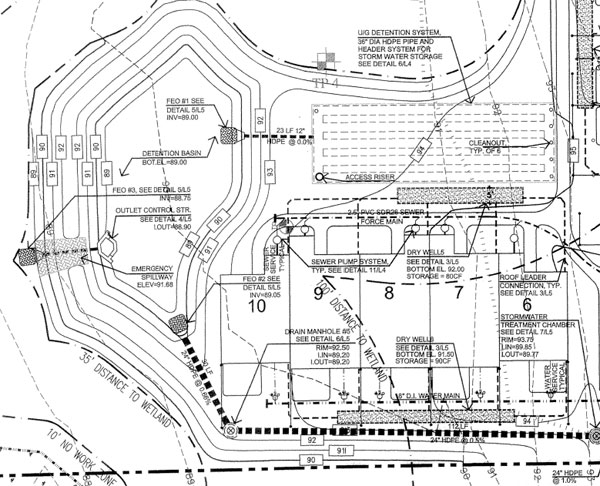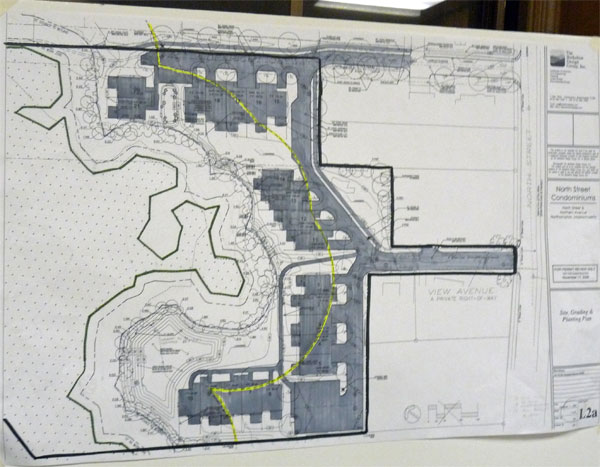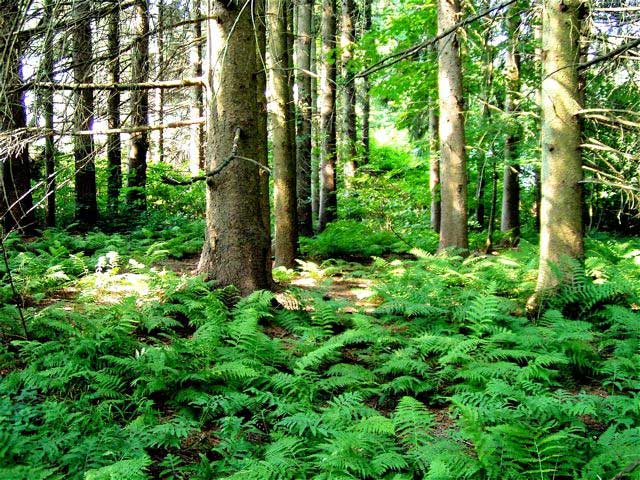At the February 26 Conservation Commission hearing regarding Kohl Construction’s North Street condo proposal, Jono Neiger of Regenerative Design Group noted that removing large numbers of mature trees, as Kohl proposes to do, may cause the already high water table to rise even further. In Kohl’s Stormwater Drainage Report (PDF, 2.8MB, submitted 3/6/09), seasonal high groundwater at test pits 1 (to the left of condo unit 11) and test pit 2 (under condo unit 2) is currently just 18″ below the surface.
Research cited below finds that the “sites most susceptible to [hydrology] changes after clearcutting were the transition ones between the bogs or fens and the uplands.” This appears to describe well the land Kohl proposes to remove trees from. An average rise on the order of 20 cm (7.9 inches) in the water table is plausible. This could put unanticipated strains both on the foundations of the condos and on the stormwater mitigation system, a major component of which is underground. In addition, “the clear-cut of riparian and other wetland vegetation may lead to ecosystem conversion, i.e., to the encroachment…of
water-tolerant or of shallow-rooted invasive species.” Conservation and Land Use Planner Bruce Young has shown a keen interest in controlling invasive species on Kohl’s land.
The phenomenon of groundwater rising after tree harvests is common enough to have its own term: “watering-up”. Here is scientific research on this subject:
Relative importance of interception and transpiration changes causing watering-up after clearcutting on four wet sites
Authors: Stéphane Dubé; André P. Plamondon (1995)
The watering-up phenomenon after clearcutting on forested wetlands has been relatively well documented worldwide (review by Dubé, 1994). In Canada, the recent study of Dubé (1994) in the St Lawrence lowlands and the studies of Haavisto et al. (1986); Berry & Jeglum (1991) in the spruce forest lands of northeastern Ontario represent the first well documented quantitative information on this subject.
These studies referred to “watering-up” as the rise of the water table after logging in response to reduced transpiration and interception (Heikurainen, 1967), often accentuated by water ponding and damming from roads or skid trails (Aust et al., 1993)…
Interception and évapotranspiration were studied at four sites (sites C, I, H and D, Table 1) representing a fen with seepage, a bog, a peaty gley soil (or swamp) and a gleyed mineral soil according to Dubé et al. (1993)…
The increase of water table levels especially during periods of low rainfall indicates a decrease of évapotranspiration on all sites after clearcutting. Decreasing évapotranspiration by harvesting was reported by Pâivànen (1974) on peatlands and by Levy (1990) on a wet mineral soil. After cutting, the average watering-up was 20 cm on the gleyed mineral soil (D) and 6-7 cm on the peaty gley soil (H), fen (C) and bog (I) (Dubé, 1994). These results indicated that sites most susceptible to hydrologic changes after clearcutting were the transition ones between the bogs or fens and the uplands… [emphasis added]
During the pre-harvest period (1991), interception on sites D, H, C and I ranged between 35% and 41% of the 524 mm growing season precipitation (Table 2)…
The reduction of interception accounted for 50% or more of the total decrease of évapotranspiration after clearcutting. It appears that the importance of reduced interception in accounting for watering-up increases as the water table approaches the surface, as observed in the bog. In this case, the reduction of transpiration by cutting is partly compensated by surface evaporation. Wet sites most susceptible to forest harvesting were the transition ones between peatlands and upland sites.
Watering up after clear-cutting on forested wetlands of the St. Lawrence lowland
Authors: Stéphane Dubé; André P. Plamondon; Richard L. Rothwell (1995)
Abstract: Clear-cutting on wetlands of the St. Lawrence lowlands raised the water table levels on seven of the eight studied sites encompassing five forest types and four soil subgroups. Water table levels dropped 3 cm after clear-cutting on the eighth site, which was the wettest site with precut water levels within the top 10 cm. This was explained by evaporation from exposed water surfaces. The magnitude of the water table rises increased with the depth of the precut water table. The seasonal mean and maximum rise were respectively 20 and 52 cm on a poorly drained mineral soil which had the lowest precut water table levels. The smallest rises, with means around 7 cm, were associated with high precut water table on bogs and on fens. The watering up was not reduced on fens where a lateral flow occurs. This study indicated that transition sites between the bogs or fens and the uplands were most susceptible to hydrologic changes after clear-cutting. Watering up was caused by reduced evapotranspiration, of which the major component was interception. [emphasis added]
Changes in surface water table depth and soil physical properties after harvest and establishment of loblolly pine (Pinus taeda L.) in Atlantic coastal plain wetlands of South Carolina
Authors: Yi-Jun Xu; James A. Burger; W. Michael Aust; Steven C. Patterson; Masato Miwa; David P. Preston (2001)
The surface water table is an important factor determining soil chemical, physical and biological processes, and thus affects the functions of forested wetlands. The objective of this study was to assess surface water table dynamics from timber harvesting through early forest plantation establishment in a coastal plain wetland area located in the southeastern United States. Simulated harvesting patterns included two replicates of clear-cutting when soils were dry (dry-weather harvest), three replicates of clear-cutting when soils were wet (wet-weather harvest), and one replicate of uncut control in three 20 ha wetland loblolly pine (Pinus taeda L.) forests of ages 20, 23 and 25 years. After harvesting, two site preparation levels (non-bed and bed; bedding is a tillage process of preparing a series of parallel ridges) were randomly assigned to both dry-weather and wet-weather harvested plots, while an additional level (mole-plow+bed) was assigned only to the wet-weather harvested plots. The harvest treatments were designed to create a broad gradient of surface soil disturbance, while the site preparation treatments were done to encompass a range of site drainage and aeration conditions. Areal changes in soil bulk density, macro- and total porosities, and saturated hydraulic conductivity following harvesting were quantified. The depths of water table were recorded at monthly intervals on a 20 m×20 m grid across the 15 clear-cut and three uncut control plots (a total of 1409 PVC slotted wells) over 6 years (1992–1998), subdivided into five periods: pre-harvest, post-harvest, site preparation, and first year and second year after forest plantation establishment. The results showed that compared to the uncut control, the surface water table depth during a 1-year post-harvest period rose 14 cm for the dry-weather harvested site and 21 cm for the wet-weather harvested site. [emphasis added]
Ecophysiology of Northern Spruce Species: The Performance of Planted Seedlings
Author: Steven C. Grossnickle (2000, pages 38-42)
Forest soils become anaerobic whenever the soil oxygen concentration is reduced by an elevated water talbe and when an impermeable subsoil or flooding reduces soil aeration (Kozlowski 1982). Air-filled pore spaces are eliminated in stagnant water, causing root and shoot growth to decline markedly, even in flood-tolerant species… water logged soils can quickly become devoid of oxygen needed for seedlings to function properly… Roots are damaged in flooded soils from the lack of oxygen, which causes roots to produce ethylene and toxic substances (Kozlowski 1982) and this has a direct effect on the performance of spruce seedlings (Section 3.5.2.2). Harvesting practices can affect the water table of low-lying boreal forest sites. For examples, clear-cutting on wetland northern latitude sites can cause the water table to rise into the surface layers where it can come in contact with the root systems of recently planted seedlings (Dubé et al, 1995).
Removal of the forest canopy alters the hydrologic cycle of the reforestation site. Trees intercept precipitation that, depending upon climate and canopy architecture, may eventually reach the soil or may evaporate from the forest canopy. In conifer forests, the forest canopy can intercept 20-85% of the rainfall before it reaches the ground (Benecke 1976; Geiger 1980), while hardwood-dominated forest canopies intercept from 10 to 50% of total rainfall (Benecke 1976). The wide range in canopy interception values is due, in part, to species shoot structure and leaf characteristics. Removal of the forest canopy can increase the amount of precipitation (up to 15-50% more) reaching the soil surface (Hungerford 1979; Jansson 1987) (Fig. 1.3.1b)… [emphasis added]
Tree removal also results in lower total stand transpiration rates. The leaf area of a forested stand is much higher than shrubs and herbs that occupy a clear-cut site (Hornung and Newson 1986), and this reduces site evapotranspiration (Miller 1983)… In low-lying areas, there may be a rise in the water table after removal of the forest canopy (Williams and Lipscomb 1977).
Northern Forested Wetlands: Ecology and Management
Editor: Carl C. Trettin (1997, pages 239-247)
It has been demonstrated in an extensive review of watershed studies by Bosch and Hewlett (1982) that tree felling reduces the evapotranspiration loss. The increased amount of water available on the site has considerable consequences in forested wetlands since the hydrological regime is the main environmental driving force (Verry, 1988; Lugo, 1990; Bridgham et al., 1991). The major change following clearcutting is the rise of the water table, referred to as “watering-up”, which may delay regeneration (Bolghari, 1986) and reduce productivity of the site by decreasing the depth of the aerated zone for tree root exploitation (Heikurainen et al., 1964 in Mannerkoski, 1985)…
Hydrological studies to investigate watering-up have been conducted in many countries. An extensive review can be found in Dubé et al. (1995). The general conclusions from these studies are that decreases in the rate of transpiration and interception are responsible for the watering-up (Heikurainen, 1967). Also, the magnitude of the rise is directly related to the percentage of wood cut (Heikurainen and Pâivànen, 1970; Pâivànen, 1980), to the depth of the original water table (Heikurainen, 1967; Pâivànen, 1980), and to the time water is available near the soil surface (Verry, 1980). Recently, Dubé et al. (1995) confirmed that clearcuttings, even on 1 ha, caused rises of the water table in the St. Lawrence Lowlands and that reduced interception appeared to be the most important parameter responsible…
After cutting, the water table in the clearcut treatment on all lines rose in comparison to their respective controls (Figure 4).
…mean water table levels were elevated by 5, 4, and 6 cm after clearcutting on lines 1, 2, and 3 respectively (Table 4). This is in agreement with Heikurainen and Pâivànen (1970), who found a rise of 5 cm after clearcutting when the control water table was 25 cm deep…
…observation agrees with Verry (1980, 1988), who suggested that when the water table is within 30 cm of the surface, harvesting will increase the fluctuations of the water table. The proportion of net precipitation reaching the water table is probably responsible for these increased fluctuations…
In the undrained plots, the water table levels after both thinnings were higher by 8 and 10 cm (Table 7), which is comparable to results from Heikurainen and Pâivànen (1970) for the same level of thinning intensity…
Effect of vegetation–water table feedbacks on the stability and resilience of plant ecosystems
Authors: Luca Ridolfi; Paolo D’Odorico; Francesco Laio (2006)
[3] The two-way interaction between vegetation and groundwater is one of the key mechanisms affecting the dynamics of wetland vegetation. There is broad experimental evidence that phreatophyte vegetation, i.e., plants relying on water from the phreatic aquifer, affects the average depth and the diurnal fluctuations of the local water table, as suggested by significant increases in water table elevation (or ‘‘watering up’’ [Dubé et al., 1995]) subsequent to the removal of riparian vegetation [e.g., Wilde et al., 1953; Peck and Williamson, 1987; Borg et al., 1988; Riekerk, 1989] and by the opposite effect observed after planting vegetation in areas with relatively shallow water tables [Wilde et al., 1953; Chang, 2002]. Vegetation–water table interactions occur also in forested wetlands [Dubé et al., 1995; Roy et al., 2000], and salt marshes [Dacey and Howes, 1984; Ursino et al., 2004]. The water table drop caused by the presence of vegetation is generally attributed to lower recharge rates due to rainfall interception and plant transpiration [e.g., Wilde et al., 1953; Borg et al., 1988; Riekerk, 1989; Dubé et al., 1995], and to uptake by ‘‘taproots’’ extracting water directly from the (unconfined) aquifer [e.g., Le Maitre et al., 1999].
[4] Waterlogging conditions resulting from post-clear-cut water table rise may, in turn, inhibit seedling establishment and growth [Wilde et al., 1953], thereby preventing the regeneration of forest stands (Figure 1). In fact, the anaerobic conditions existing in saturated soils are detrimental to the root system and reduce both the productivity and the rate of survival of new seedlings [Roy et al., 2000, and references therein; Chang, 2002]. As a result, the clear-cut of riparian and other wetland vegetation may lead to ecosystem conversion, i.e., to the encroachment (Figure 1) of water-tolerant or of shallow-rooted invasive species [Chambers and Linnerooth, 2001; Wright and Chambers, 2002; Roy et al., 2000].
…wetland ecosystems are vulnerable to disturbances and may respond to biomass losses with highly irreversible catastrophic shifts to unvegetated conditions. Recovery from this stable state with no change in the externally driven hydrologic controls…is not likely to occur. However, water-tolerant and shallow-rooted species…can colonize the systems thanks to their competitive advantage in waterlogged soils…
[emphasis added]
Water table rise after harvesting in a treed fen previously drained for forestry
Authors: Sylvain Jutras; André P. Plamondon (2005)
Water table rise, also called watering-up, has been observed on undrained forested peatlands in Canada after timber harvesting (Dubé et al. 1995, Roy et al. 1997, Roy et al. 2000b). Observations of watering-up have also been made after harvesting in forested peatlands previously drained in Finland (Heikurainen & Päivänen 1970, Päivänen 1980)…
Watering-up was evident in locations where drainage was inefficient…
Watering-up occurred when drainage was unable to lower the water table level by more than 10 cm.
See also:
Kohl Files Narrative and Drainage Report with Revised Condo Proposal; Interpreting the Wetlands Ordinance
The Conservation Commission will review this latest submission at its
March 12 meeting, 6:15pm in the City Hall Hearing Room, 2nd floor
(enter via the back door). Concerned citizens are urged to attend…
…Attorney Pill leans hard on promotion of infill in justifying his
interpretation of the Wetlands Ordinance. Here is how the Notre Dame
School of Architecture defines “infill” in Envisioning Sustainable Northampton:
“Infill:
noun – new development on land that had been previously developed,
including most greyfield and brownfield sites and cleared land within
urbanized area. verb- to develop such areas.” (page G3)
This definition is not a good fit with most of Kohl’s land off North
Street. This land is largely undeveloped and uncleared, and currently
contains just one single-family house (8 View Avenue). It also contains one of downtown’s few remaining groves of mature trees and buffers a wetland. Responsible–sustainable–infill should not be interpreted as a license to pave over a city’s green infrastructure.
Below is a special area of concern in Kohl’s proposal. Test pit data
suggests the bottom of the detention basin on the left is less than two
feet from seasonal high groundwater. Water may stagnate in this basin with a risk of poor stormwater management and mosquito problems. On the right is an underground stormwater detention system. Underground detention basins were recently found to be failing at Bridge Street School and will be bypassed at a cost of $22,000.

Video: Kohl Presents Revised Proposal to Conservation Commission on February 26
Neiger exhibited this chart which makes clear the amount of impervious
surface Kohl proposes to add to this currently green area. The yellow
line denotes the 100-foot buffer zone around the Millyard Brook
wetland. The impact of the project extends beyond the impervious
surface, as construction work and the stormwater systems would
necessitate the removal of many additional mature trees up to the
35-foot buffer line.

Massachusetts Audubon: The Value of Floodplain Forests
Floodplain forest…is a disappearing ecological treasure… [Their]
cyclical flooding regime continually refertilizes the floodplain and
nourishes the well-adapted trees and understory…
“Apart from
preserving ecological habitat, a wildlife corridor, and a greenway,”
says Blunt, “the DCR has some very practical reasons for restoring
these [floodplain forests along the Connecticut River].” The broad
areas of the floodplain forest are natural water-storage areas. During
significant floods—and such events can occur any time of the year—water
overspreads the flat wetlands and loses velocity. The trees act as
filter strips, holding back sediments and reducing the extent of
downstream damage…
“Putting housing [in the Belmont Uplands]
would be totally un-smart growth,” says FAR’s Ellen Mass. “Basically,
the people living here would be surrounded by a mosquito marsh.”
Photo Essay: Our Woods in Fall
Photo Essay: Arbor Day and the North Street Woods
Photo Essay: Millyard Brook Swells with Water in Winter
…On
January 11, a mild and rainy day, Millyard Brook is…helping a large
volume of water flow safely through the neighborhood. Adding impervious
surface near streams like these can increase the speed and volume of runoff that flows into them and make them more flood-prone. In addition, the pollution from developed areas (e.g. salts, oils, herbicides) can harm the vegetation. As the City of Northampton acknowledges,
“Problems with nutrient runoff, erosion, siltation, loss of groundwater
recharge, poor water quality, vegetation change and harm to wildlife
habitat are greatly exacerbated by activities within 100 feet of
wetlands.”
Photo Essay: Our Woods in Winter
Photo Essay: The Forest Behind View Avenue
